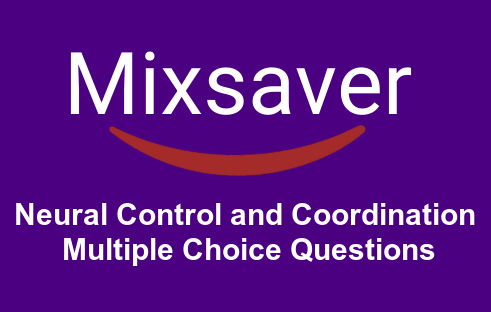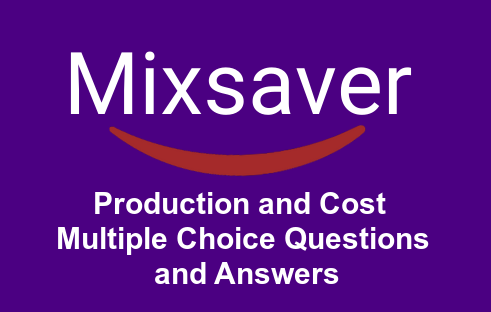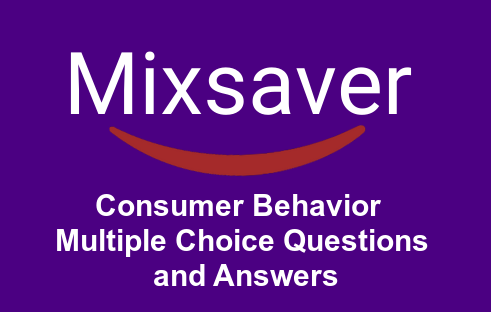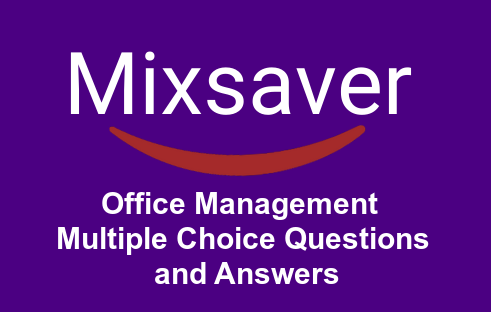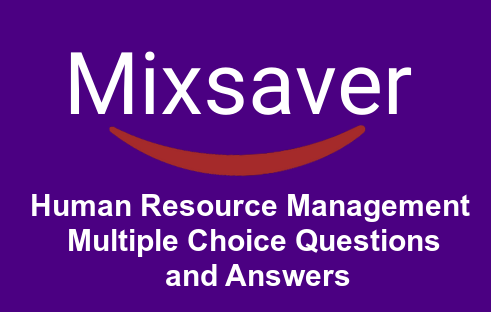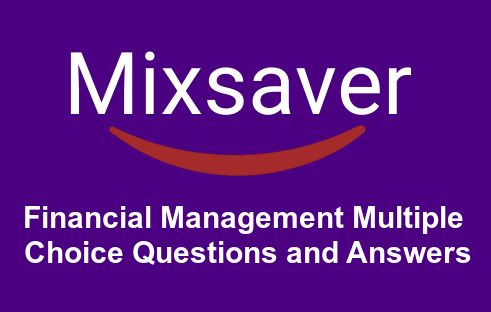Neural Control and Coordination NEET Questions
1. Which of the following statements is true?
(a) Peripheral nerve is similar to smooth muscle in terms of the connective tissue investment
(b) Most nerves contain afferent and efferent fibres and thus. carry both motor and sensory signals
(c) Nodes of Ranvier are most easily seen in cross-section of peripheral nerve
(d) None of the above
Ans. b
2. Which of the following cells is responsible for myelin formation in the peripheral nervous system?
(a) Astrocyte
(b) Oligodendrocyte
(c) Schwann cell
(d) Microglial cell
Ans. c
3. The peripheral nervous system includes the
(a) somatic nervous system
(b) brain
(c) spinal cord
(d) nuclei
Ans. a
4. The system that controls smooth muscle, cardiac muscle and gland activity is the
(a) somatic nervous system
(b) autonomic nervous system
(c) skeletal division
(d) sensory nervous system
Ans. b
5. A neuron with many short dendrites and a single long axon is a
(a) multipolar neuron
(b) bipolar neuron
(c) unipolar neuron
(d) None of these
Ans. a
6. Most sensory neurons are ….. neurons.
(a) unipolar
(b) bipolar
(c) multipolar
(d) Both (a) and (b)
Ans. c
7. Cells found in the choroid plexus that secrete cerebrospinal fluid are
(a) astrocytes
(b) microglia
(c) ependymal cells
(d) oligodendrocytes
Ans. c
8. The most likely type of fibre that would carry the impulse for a withdrawal reflex would be a
(a) fibre because they carry the strongest action potentials
(b) fibre because they carry APs the fastest
(c) fibre because they carry APs the fastest
(d) fibre because they carry the strongest APs
Ans. b
9. Axons within nerves may have which of the following associated with them?
(a) Schwann cells
(b) Nodes of Ranvier
(c) Oligodendrocytes
(d) Both (a) and (b)
Ans. d
10. Action potentials are conducted more rapidly in
(a) srnail diameter axons than large diameter axons
(b) large diameter axons than small diameter axons
(c) unmyelinated axons than myelinated axons
(d) axons that lack a wrapping of Schwann cells
Ans. b
Neural control and coordination neet mcq pdf download
11. Clusters of nerve cell bodies within the PNS are called
(a) neuron
(b) nerve
(c) ganglia
(d) lymph
Ans. c
12. Gray matter contains primarily
(a) myelinated fibres
(b) neuron cell bodies
(c) Schwann cells
(d) All of these
Ans. b
13. In the cochlea, the hair cells are contained by the
(a) tectorial membrane
(b) tympanic membrane
(c) basilar membrane
(d) vestibular membrane
Ans. c
14. The amount of light entering the eye is determined by the size of the
(a) retina
(b) conea
(c) pupil
(d) fovea
Ans. c
15. The cells responsible for colour vision in vertebrates are called
(a) rod cells
(b) cone cells
(c) bipolar cells
(d) cupula cells
Ans. b
16. Each of the following is an amino acid derivative except
(a) epinephrine
(b) melatonin
(c) thyroxine
(d) TSH
Ans. a
17. Corpus striatum is
(a) thin walled
(b) thick walled
(c) ependymal
(d) None of these
Ans. b
18. Brain depends upon food for the supply of
(a) ATP and glucose
(b) oxygen
(c) electrolytes
(d) O2 and glucose
Ans. d
19. Which does not act as neurotransmitter?
(a) Acetylcholine
(b) Epinephrine
(c) Cortisone
(d) Norepinephrine
Ans. c
20. Ratio of Na* and K* ion across nerve membrane is
(a) 50 : 40
(b) 60 30
(c) 30: 10
(d) 25: 10
Ans. d
Chemical coordination and integration mcq for neet pdf download
21. Which one is not a reflex action?
(a) Sneezing
(b) Coughing
(c) Pawning
(d) Weeping
Ans. d
22. Ventricle connecting medulla oblongata with optical cord in
(a) 4th
(b) 5th
(c) 3rd
(d) 2nd
Ans. a
23. Longest nerve of head region is
(a) vagus
(b) trigeminal
(c) pathetic
(d) auditory
Ans. b
24. Synapse bringing together of
(a) 2 venules
(b) 2 veins
(C) 2 arteries
(d) 2 neurons
Ans. d
25. Cranial nerve showing maximum branching in
(a) trigeminal
(b) vagus
(c) optic
(d) facial
Ans. b
26. Which one is the spinal nerve?
(a) Trigeminal
(b) Hypoglossal
(c) Oifactory
(d) None of these
Ans. d
27. Arbor vitae is composed of
(a) grey matter
(b) white matter
(c) neuroglia cells
(d) All of these
Ans. d
28. Vasomotor nerve are
(a) sympathetic
(b) parasympathetic
(c) Both (a) and (b)
(d) None of these
Ans. c
29. Nerve depolarisation is maintained by
(a) Ca2+
(b) Mg2+
(c) K+
(d) CI-
Ans. c
30. Vagus nerve is
(a) X
(b) IX
(c) VII
(d) V
Ans. a
Neural control and coordination neet questions pdf
31. Sixth crania? nerve is
(a) oculomotor
(b) olfactory
(c) optic
(d) abducens
Ans. d
32. The nerves carrying impulses to CNS are known as
(a) motor
(b) efferent
(c) afferent
(d) mixed
Ans. c
33. Which part of nervous system is activated under stress?
(a) Autonomous nervous system
(b) Parasympathetic nervous system
(c) Sympathetic nervous system
(d) Spinal cord
Ans. c
34. Pons connects
(a) brain with spinal cord
(b) cerebrum with cerebellum
(c) two lobes of cerebellum
(d) two cerebral hemispheres
Ans. a
35. White matter of spinal cord contains
(a) nerve axons
(b) cell bodjes
(c) clusters of neurons and cell bodies
(d) motor neurons
Ans. a
36. Each cerebral hemisphere is divided into how many lobes?
(a) Three
(b) Four
(c) Five
(d) Six
Ans. b
37. The part of the hindbrain that is responsible for hand-eye coordination is
(a) pons
(b) hippocampus
(c) medulla oblongata
(d) cerebellum
Ans. d
38. Transmission of nerve impulse at synapses is a
(a) biological process
(b) physical process
(c) chemical process
(d) mechanical process
Ans. c
39. Myopia can be corrected by
(a) cylindrical lens
(b) bifocal lens
(c) biconvex lens
(d) biconcave lens
Ans. d
40. Which cranial nerve is purely sensory?
(a) Abducens
(b) Auditory
(c) Vagus
(d) Spinal accessory
Ans. b
Control and coordination class 12 mcq pdf | Neural control and coordination mcq | Chemical coordination and integration mcq
41. Depolarisation of nerve cell involves
(a) influx of K+
(b) influx of Na+
(c) influx of Ca2+ and CI-
(d) efflux of Na+
Ans. b
42. Brain and spinal cord are
(a) etfectors
(b) receptors
(c) nervous drgans
(d) intermediary neurons
Ans. c
43. The lacrimal gland is innervated by the
(a) tacial cranial nerve
(b) optic cranial nerve
(c) ophthalmic nerve
(d) oculomotor cranial nerve
Ans. c
44. Movement of the eye outward away from the nose function of which muscle?
(a) Superior rectus
(b) Lateral rectus
(c) Inferior oblique
(d) Superior oblique
Ans. b
45. Anerveconveying impulse from a tissue to nerve centra
(a) afferent
(b) efferent
(c) mixed
(d) None of these
Ans. a
46. Man can see objects equally clear from various distanes due to
(a) cornea
(b) conjunctiva
(c) eye lid
(d) ciliary muscles
Ans. d
47. Which one of these is the spinal nerve?
(a) Trigeminal
(b) Hypoglossal
(c) Olfactory
(d) None of these
Ans. d
48. Saltatory conduction is superior to uninterrupted conduction because of
(a) less energy required
(b) more speed
(c) less Na+/K+pump
(d) All of these
Ans. d
49. Respiration, heartbeat and peristalsis are controlled by
(a) medulla oblongata
(b) hypothalamus
(c) amygdala
(d) cerebellum
Ans. a
50. The receptor organs for sense of hearing are located in
(a) cochlea
(b) utriculus
(c) sacculus
(d) middle ear
Ans. a
Neural control and coordination neet mcq | neet questions on neural control and coordination | MCQ on neural control and coordination
51. Lens in man is
(a) biconvex
(b) biconcave
(c) spherical
(d) cylindrical
Ans. a
52. Parasympathetic fibres arise from which set of cranial nerves?
(a) III, V, IX, X
(b) IV, V, IX, X
(c) II, VII, IX, X
(d) V, IX, X, XII
Ans. c
53. The autonomic nervous system is responsible for which function(s)?
(a) Motor
(b) Sensory
(c) Motor and sensory
(d) None of these
Ans. b
54. Colour to the eye is imparted by
(a) lens
(b) pupil
(c) iris
(d) vitreous humour
Ans. c
55. The pigment that helps eye to see in dim light is
(a) iodopsin
(b) rhodopsin
(c) haemocyanin
(d) haematin
Ans. b
56. In man’s eye, the sclerotic layer is made up of
(a) bone
(b) cartilage
(c) muscles and cartilage
(d) fibrous connective tissue
Ans. c
57. The rectus eye muscle capable of causing the eye ball to rurn laterally in a horizontal plane is innervated by which cranial nerve?
(a) Optic nerve
(b) Abducens nerve
(c) Facial nerve
(d) Oculomotor nerve
Ans. b
Neural control and coordination mcq pdf | Neural control and coordination mcq pdf for neet | Chemical coordination and integration mcq for neet pdf
58. Which region of the brain is farthest from the spinal cord?
(a) Mesencephalon
(b) Telencephalon
(c) Metencephalon
(d) Diencephalon
Ans. b
59. Which is not a lobe of the cerebrum?
(a) Parietal lobe
(b) Insula
(c) Occipital lobe
(d) Sphenoidal lobe
Ans. d
60. Acetylcholine takes part in KGIG
(a) enhancing membrane permeability
(b) synaptic transmission
(c) synaptic delay
(d) None of the above
Ans. b
61. Eye muscles are attached with
(a) sclerotic
(b) cornea
(c) choroid
(d) retina
Ans. a
62. The activities of equilibrium, balancing and coordination of muscles are governed by
(a) medulla oblongata
(b) cerebrum
(c) cerebellum
(d) pineal
Ans. c
63. Which two structures of the brain control respiration?
(a) Pons and hypothalamus
(b) Cerebrum and hypothalamus
(c) Pons and medulla oblongata
(d) Hypothalamus and pituitary gland
Ans. c
64. Ear drum is
(a) tensor tympani
(b) scala tympani
(c) tympanic membrane
(d) scala vestibuli about the
Ans. c
65. Consider the following statements parasympathetic division of the ANS.
I. All its neurons release acetylcholine as their primary neurotransmitter substance
II. The cell bodies of its postganglionic neurons lie in or near the organ innervated
III. The cell bodies of its preganglionic neurons lie in the cervical and sacral spinal cord Of these statements
(a) All are true
(b) None are true
(c) I and Il are true
(d) Il and III are true
Ans. c
66. II, VII, VIII and IX cranial nerves are
(a) optic, facial, auditory, glossopharyngeal
(b) optic, auditory, facial, hypoglossal
(c) oculomotor, auditory, abducens, hypoglossal
(d) optic, facial, abducens and glossopharyngeal
Ans. a
67. Synapse is bringing together of two
(a) venules
(b) veins
(c) arteries
(d) neurons
Ans. d
68. Touch on the right side stimulate neurons on
(a) right somatic sensory area
(b) right somatic motor area
(c) left somatic sensory area
(d) Both (b) and (c)
Ans. c
69. Afferent nerve fibres carry impulses from
(a) effector organs to CNS
(b) receptors to CNS
(c) CNS to receptors
(d) CNS to muscles
Ans. b
70. Focal length of eye lens is changed by
(a) pupil
(b) iris
(c) cornea
(d) ciliary body
Ans. c
71. The visual purple is concerned with bau to coqeT
(a) bright light
(b) dim light
(c) moderate light
(d) darkness
Ans. b
72. Convex lenses correct
(a) presbyopia
(b) myopia
(c) hypermetropia
(d) glaucoma
Ans. c
73. Once the nerve has been stimulated, it cannot be stimulated again for sometime; this period is called the
(a) refractory period
(b) period of excitability
(c) period of summation
(d) None of the above
Ans. a
74. Organ of Corti sends information to brain through which cranical nerve?
(a) V
(b) VI
(c) VII
(d) VIII
Ans. d
75. Which portion of the cochlea responds to low frequency sound waves?
(a) The portion closest to the vestibular window
(b) The middle portion
(c) The portion closest to the cochlear nerve
(d) The end portion
Ans. c
